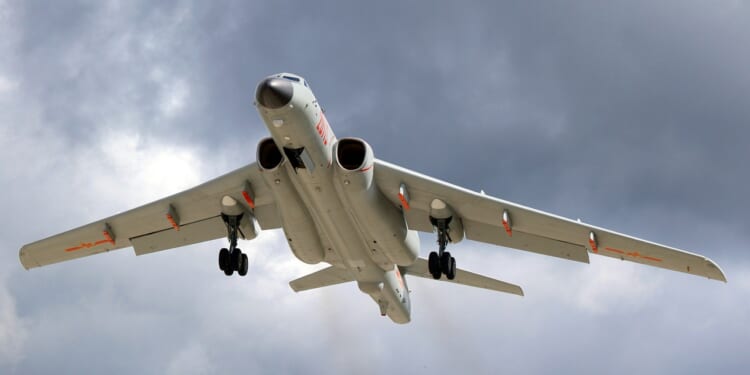The H-6 is an effective bomber—but as time goes on and anti-air defenses grow stronger, it will become more and more obsolete on the modern battlefield.
China’s H-6 “War God” strategic bomber is one of the longest-serving combat aircraft in the world, having evolved beyond its Cold War origins to retain relevance. Originally a license-built copy of the Soviet Tupolev Tu-16 in the 1950s, the H-6 has evolved, through decades of modification, into a fairly modern standoff strike platform that is central to Beijing’s power-projection strategy. Still, the H-6 is likely to be phased out, in favor of the (rumored) forthcoming H-20 stealth bomber, a platform more well suited for modern combat and denied airspace operations than the decades-old H-6.
The H-6 Bomber’s Specifications
- Year Introduced: 1959 (original); ~2011 (H-6K upgraded variant)
- Number Built: ~200–300 (all variants)
- Length: ~107 ft (32.8 m)
- Wingspan: ~108 ft (33.0 m)
- Weight (MTOW): ~141,000 lb (64,000 kg)
- Engines: Two D-30KP/WS-18 turbofans
- Top Speed: ~530 knots (610 mph, 980 km/h)
- Range: ~1,240 mi (2,000 km) combat radius
- Service Ceiling: ~45,000 ft (13,700 m)
- Loadout: Up to 6 CJ-20 ALCMs or anti-ship missiles; some variants with refueling probe or central hardpoint for large payloads
- Crew: 3
Why China Built the H-6 Bomber
The H-6 is a twin-engine subsonic medium bomber, comparable in size to the retired American B-47 Stratojet bomber. While earlier variants of the H-6 featured turbojet engines, the newest variants feature more efficient turbofans, offering improved range, payload, and reliability. The H-6 can cruise around Mach 0.75 at altitudes near 40,000 feet, with a combat radius in the low thousands of kilometers. The flight crew typically consists of three service members, who operate a cockpit and avionics suite that has been modernized with glass displays, digital mission computers, and datalinks.
At its heart, the H-6 is a weapons delivery platform. Accordingly, the H-6K features redesigned wings with six underwing pylons capable of carrying heavy air-launched cruise missiles (ALCMs) such as the CJ-20, a weapon with a range in excess of 1,000 kilometers. The ability to launch ALCMs transforms the H-6 from a free-fall munitions platform into a standoff missile truck able to launch precision strikes far from hostile air defenses.
Newer variants, like the H-6J and the H-6N, have further optimized the platform’s abilities, offering maritime strike enhancements, advanced electronic warfare systems, and in the case of the H-6N, an aerial refueling probe and a semi-recessed belly mount thought capable of carrying a larger air-launched ballistic or hypersonic missile.
Should America Fear the H-6 in the Indo-Pacific?
Operationally, the H-6 is used as a regional power-projection asset. Stationed at mainland airbases, the H-6 can reach deep into the Western Pacific, covering potential flashpoints such as Taiwan, the South China Sea, and even Guam when equipped with ALCMs. In peacetime, the H-6 is often deployed on routine patrols, around Taiwan or through the Miyako Strait—which serve as a strategic signaling tool, demonstrating presence and to assert Chinese resolve. In wartime, the H-6 could be used to saturate regional defense systems with volleys of precision missiles launched from beyond the reach of interceptors.
The H-6 is primarily useful to Beijing for its low-cost force multiplication. Thanks to relative affordability, the H-6 can provide long-range strike capacity without exorbitant costs. The H-6 can also serve as a bridge until the H-20 is fielded—giving China a true stealth bomber platform.
Still, the H-6’s weaknesses are obvious. The platform could not survive in modern defended airspace, and would depend heavily upon escorts, electronic-warfare support, and the long reach of its missiles. The H-6 is a regional platform, well-suited for China’s regional needs. But as China’s ambitions grow, as Beijing looks beyond its own coastlines, the H-6’s limitations will become more and more pronounced.
About the Author: Harrison Kass
Harrison Kass is a senior defense and national security writer at The National Interest. Kass is an attorney and former political candidate who joined the US Air Force as a pilot trainee before being medically discharged. He focuses on military strategy, aerospace, and global security affairs. He holds a JD from the University of Oregon and a master’s in Global Journalism and International Relations from NYU.
Image Shutterstock / Fasttailwind.


















